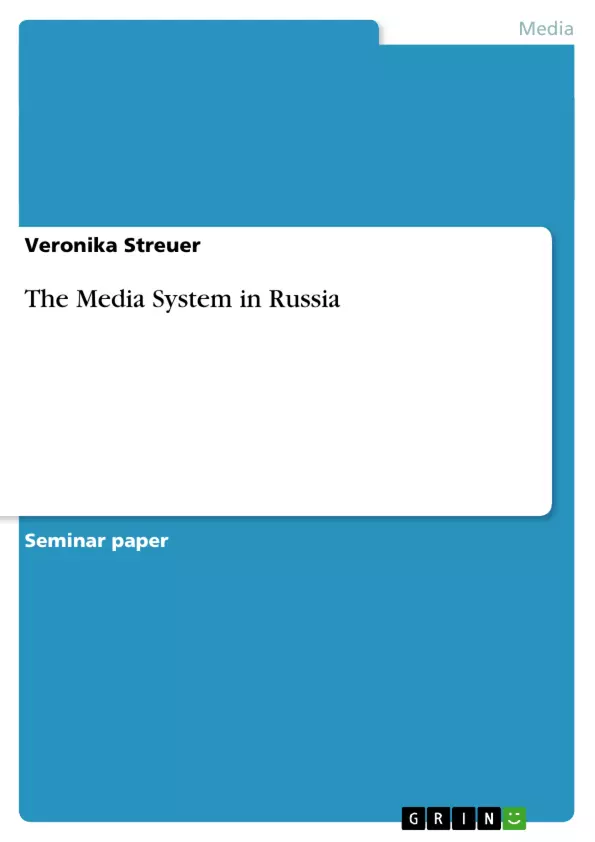This essay analyses the Russian media system on the basis of the concept of comparing media systems developed by Daniel C. Hallin and Paolo Mancini in 2004. Therefore a brief sketch about the Russian media system is given in the second section of this essay. Section three contains an overview about Hallin and Mancini’s approach of comparing media systems, which also will be discussed briefly. The advantages and drawbacks of using this concept on Russia will also be pointed out. In section four the tool mentioned above will be used to analyse the Russian media system. In section five it is discussed whether the Russian media system could fit in one of the three models approached by Hallin and Mancini. Concluding this essay suggests the development of a new fourth model to describe the specifics of Post-Soviet countries.
Inhaltsverzeichnis (Table of Contents)
- Introduction
- The Russian media system in brief
- Hallin and Mancini's approach
- Analysis of the Russian media system
- Into a new model of media and politics
- Conclusion
Zielsetzung und Themenschwerpunkte (Objectives and Key Themes)
This essay aims to analyze the Russian media system using the framework developed by Daniel C. Hallin and Paolo Mancini in 2004. It provides a brief overview of the Russian media system, introduces Hallin and Mancini's approach, and then uses this approach to analyze the Russian media system. The essay explores the potential for fitting the Russian media system into one of the three models proposed by Hallin and Mancini and suggests the development of a new fourth model to better describe the specifics of Post-Soviet countries.
- The characteristics of the Russian media system and its evolution from the Soviet era.
- An examination of Hallin and Mancini's approach to comparing media systems, including its advantages and limitations when applied to Russia.
- Analysis of the Russian media system through the lens of Hallin and Mancini's three key dimensions: political parallelism, the development of journalistic professionalism, and the degree and nature of state intervention.
- Exploration of the potential for a new model to describe the specific characteristics of the Russian media system and other Post-Soviet countries.
Zusammenfassung der Kapitel (Chapter Summaries)
The introduction sets the stage for the essay, outlining its objectives and the methodology used to analyze the Russian media system. It highlights the importance of understanding the historical context of the Russian media system and the need for a new framework to better grasp its specific characteristics.
The second chapter presents a concise overview of the Russian media system, highlighting its diverse nature and the dominance of state-owned and state-controlled media outlets. It emphasizes the importance of television as a key media platform in Russia and discusses the role of private capital and political power in shaping the media landscape.
The third chapter introduces Hallin and Mancini's approach to comparing media systems, outlining its origins and key dimensions. It discusses the limitations of using this approach to analyze the Russian media system, given its unique historical and political context.
The fourth chapter delves into the analysis of the Russian media system using Hallin and Mancini's framework. It examines the dimensions of political parallelism, journalistic professionalism, and state intervention, highlighting the significant influence of the state and the challenges faced by independent media outlets. This chapter explores how these dimensions are manifested in the Russian media landscape.
Schlüsselwörter (Keywords)
This essay explores the Russian media system, examining its characteristics and evolution through the lens of Hallin and Mancini's model. Key terms and concepts include: political parallelism, journalistic professionalism, state intervention, media system, post-Soviet countries, autonomy of the media, politicized private capital, governmental oligarchy, and the development of a new fourth model.
- Quote paper
- B.A. Veronika Streuer (Author), 2009, The Media System in Russia, Munich, GRIN Verlag, https://www.grin.com/document/128726



